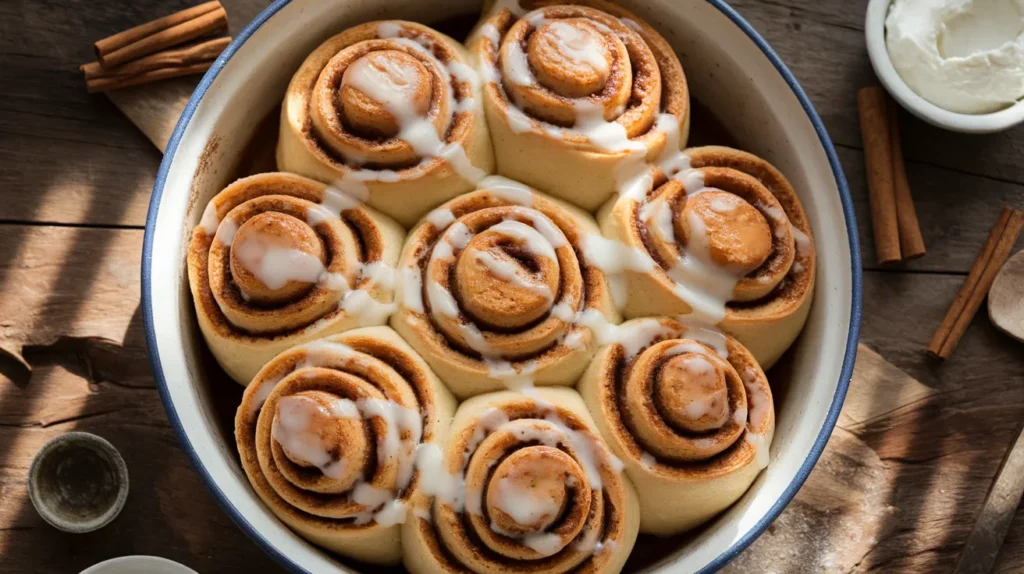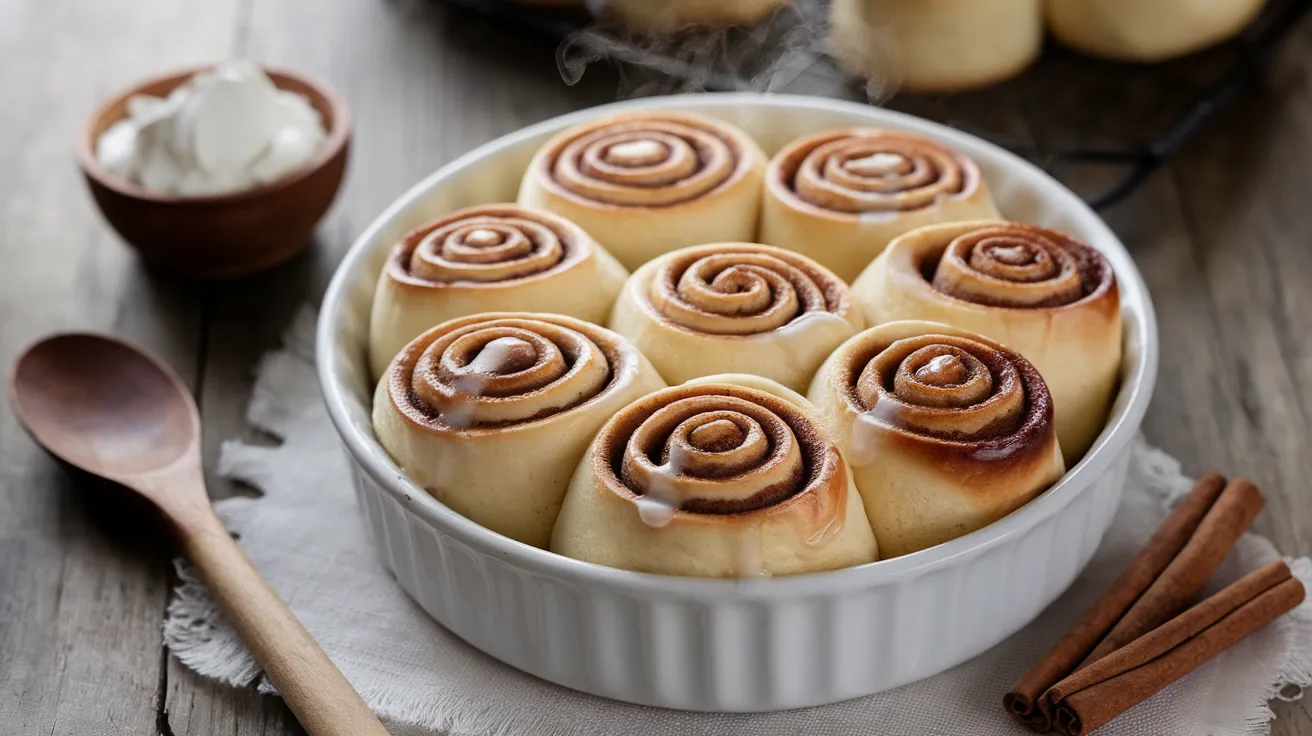These heavenly ricotta cinnamon rolls combine the creamy richness of fresh ricotta cheese with warm cinnamon spice, creating the most tender, fluffy rolls you’ve ever tasted. Perfect for weekend mornings or special occasions, these ricotta cinnamon rolls deliver bakery-quality results right from your home kitchen.
Recipe Information
SERVES: 4 | PREP: 45 MIN | COOK: 25 MIN | TOTAL: 90 MIN (including rise time)
Ingredients
For the Dough:
| Ingredient | Amount |
|---|---|
| All-purpose flour | 2½ cups |
| Whole milk ricotta cheese | ¾ cup |
| Warm milk | ¼ cup |
| Active dry yeast | 1 packet (2¼ tsp) |
| Granulated sugar | 2 tablespoons |
| Unsalted butter, melted | 3 tablespoons |
| Large egg | 1 |
| Salt | ½ teaspoon |
For the Cinnamon Filling:
| Ingredient | Amount |
|---|---|
| Unsalted butter, softened | 4 tablespoons |
| Brown sugar, packed | ⅓ cup |
| Ground cinnamon | 2 teaspoons |
| Vanilla extract | ½ teaspoon |
For the Cream Cheese Glaze:
| Ingredient | Amount |
|---|---|
| Cream cheese, softened | 2 oz |
| Powdered sugar | ¾ cup |
| Milk | 2-3 tablespoons |
| Vanilla extract | ½ teaspoon |
Step-by-Step Instructions
Phase 1: Preparing the Yeast (5 minutes)
Step 1: Heat the milk to exactly 110°F using a kitchen thermometer. The milk should feel barely warm to your wrist – too hot will kill the yeast, too cool won’t activate it.
Step 2: Sprinkle the yeast packet over the warm milk and add 1 teaspoon of the granulated sugar. Stir gently and let sit for 5 minutes until the mixture becomes foamy and bubbly. If it doesn’t foam, your yeast is dead – start over with fresh yeast.
Phase 2: Making the Ricotta Dough (15 minutes)
Step 3: In a large mixing bowl, whisk the ricotta cheese until smooth and creamy. This breaks up any lumps that could create dense spots in your ricotta cinnamon rolls.
Step 4: Add the remaining granulated sugar, melted butter, and egg to the ricotta. Whisk until completely combined – the mixture should look pale yellow and smooth.
Step 5: Pour the foamy yeast mixture into the ricotta mixture and stir until well blended.
Step 6: Add 2 cups of flour and the salt. Using a wooden spoon, mix until a shaggy dough forms. The dough will look rough and sticky at this point.
Step 7: Gradually add the remaining ½ cup flour, mixing until the dough pulls away from the bowl sides. You may need slightly more or less flour depending on humidity.
Phase 3: Kneading and First Rise (35 minutes)
Step 8: Turn the dough onto a lightly floured surface. Knead for 8-10 minutes until the dough becomes smooth, elastic, and slightly tacky (not sticky). The ricotta makes this dough softer than regular bread dough.
Safety tip: If the dough sticks to your hands, lightly flour them rather than adding more flour to the dough.
Step 9: Place the dough in a greased bowl, turning once to coat all sides. Cover with a damp kitchen towel and let rise in a warm place for 25 minutes until doubled in size.
Phase 4: Preparing the Filling and Assembly (10 minutes)
Step 10: While the dough rises, make the cinnamon filling by mixing softened butter, brown sugar, cinnamon, and vanilla extract in a small bowl until smooth and spreadable.
Step 11: Grease an 8-inch round baking pan with butter. This size ensures your ricotta cinnamon rolls have room to expand without overcrowding.
Step 12: Once doubled, punch down the dough gently to release air bubbles. Roll into a 12×8 inch rectangle on a floured surface. The dough should be about ¼ inch thick.
Step 13: Spread the cinnamon filling evenly over the dough, leaving a ½ inch border along one long edge. This border helps seal the rolls when you roll them up.
Phase 5: Rolling and Second Rise (20 minutes)
Step 14: Starting from the long edge opposite the border, tightly roll the dough into a log. Pinch the seam closed and place seam-side down.
Step 15: Using a sharp knife or dental floss, cut the log into 8 equal pieces (about 1½ inches each). Place cut-side up in the prepared pan, leaving small gaps between rolls for expansion.
Step 16: Cover with a damp towel and let rise for 15 minutes until the rolls touch each other and look puffy.
Phase 6: Baking and Glazing (30 minutes)
Step 17: Preheat your oven to 375°F during the last 5 minutes of rising time.
Step 18: Bake for 22-25 minutes until the tops are golden brown and the internal temperature reaches 190°F. The ricotta keeps these rolls incredibly moist, so don’t overbake.
Step 19: While baking, prepare the glaze by beating cream cheese until smooth, then gradually adding powdered sugar, milk, and vanilla until you reach drizzling consistency.
Step 20: Cool the ricotta cinnamon rolls in the pan for 5 minutes, then drizzle with warm glaze before serving.
Chef’s Notes
Ricotta Selection: Use whole milk ricotta for the richest flavor and texture. Part-skim works but creates slightly denser ricotta cinnamon rolls.
Temperature Matters: Always check milk temperature with a thermometer. Too hot kills yeast, while too cool prevents proper activation.
Rising Environment: Create a warm rising spot by placing the bowl on top of your refrigerator or near a sunny window.
Make-Ahead Magic: Prepare through step 15, cover tightly, and refrigerate overnight. Let come to room temperature before baking.
Nutrition Information (Per Roll)
- Calories: 285
- Protein: 8g
- Carbohydrates: 45g
- Fat: 9g
- Fiber: 2g
- Sugar: 18g
Creative Variations
Orange Ricotta Rolls: Add 1 tablespoon orange zest to the dough and 1 teaspoon to the filling for a citrusy twist that pairs beautifully with morning coffee.
Chocolate Chip Surprise: Fold ⅓ cup mini chocolate chips into the filling for an indulgent breakfast treat kids will love.
Savory Herb Ricotta Rolls: Replace cinnamon filling with a mixture of ricotta, fresh herbs, and parmesan cheese. These pair wonderfully with cloud bread with ricotta cheese for a complete brunch spread.
Almond Cream Filling: Substitute almond extract for vanilla in both dough and glaze, then sprinkle with sliced almonds. This variation complements ricotta almond flour pancakes perfectly for a ricotta-themed breakfast.
Storage & Reheating Guide
Room Temperature: Store covered for up to 2 days. The ricotta keeps these rolls moist longer than regular cinnamon rolls.
Refrigeration: Wrap tightly and refrigerate for up to 5 days. Bring to room temperature before serving for best texture.
Freezing: Freeze baked, unglazed rolls for up to 3 months. Thaw overnight and warm before glazing.
Reheating: Microwave individual rolls for 15-20 seconds or warm the entire pan in a 300°F oven for 8-10 minutes.

Troubleshooting Common Issues
Dense, Heavy Rolls: Usually caused by too much flour or inactive yeast. Check expiration dates and measure flour by spooning into cups, then leveling.
Rolls Didn’t Rise: Ensure your yeast is fresh and the milk temperature was correct. Cold kitchens slow rising – find a warmer spot.
Filling Leaked Out: The dough was rolled too thin or the filling was too wet. Keep filling thick and spreadable, not runny.
Dry Texture: Overbaking is the culprit. Check doneness at 22 minutes and remember that ricotta cinnamon rolls continue cooking slightly after removal.
Tough Dough: Over-kneading develops too much gluten. Knead just until smooth and elastic, about 8-10 minutes maximum.
Equipment Essentials
- Large mixing bowl
- Kitchen thermometer
- Measuring cups and spoons
- Rolling pin
- Sharp knife or dental floss
- 8-inch round baking pan
- Clean kitchen towels
- Wire cooling rack
Shopping List
Dairy Section:
- Whole milk ricotta cheese
- Unsalted butter
- Milk
- Large eggs
- Cream cheese
Baking Aisle:
- All-purpose flour
- Active dry yeast
- Granulated sugar
- Brown sugar
- Powdered sugar
- Ground cinnamon
- Vanilla extract
- Salt
Success Secrets
- Room Temperature Ricotta: Let refrigerated ricotta sit out for 30 minutes before using to ensure smooth mixing and even texture in your ricotta cinnamon rolls.
- Proper Yeast Activation: The foaming step is crucial – no foam means dead yeast and flat rolls. Always proof your yeast first.
- Don’t Over-Flour: Add flour gradually and stop when the dough is slightly tacky, not completely dry. Ricotta dough should feel softer than regular bread dough.
- Even Rolling: Use gentle, consistent pressure when rolling to ensure uniform thickness and prevent filling from squeezing out the sides.
- Visual Cues Over Time: Watch for the dough to double in size rather than relying solely on timing – humidity and temperature affect rising speed significantly.
These bakery-style ricotta cinnamon rolls prove that homemade doesn’t have to be complicated. The ricotta creates an incredibly tender crumb while keeping the rolls moist for days. Perfect for weekend brunches, holiday mornings, or any time you want to fill your kitchen with the irresistible aroma of fresh-baked cinnamon rolls.




